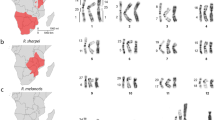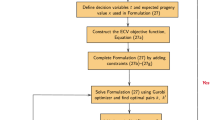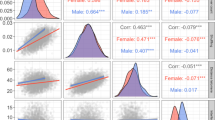Abstract
Females of the grasshopper Podisima pedestris were collected from the middle of a hybrid zone between two chromosomal races in the Alpes Maritimes. They had already mated in the field, and could therefore lay fertilised eggs in the laboratory. The embryos were karyotyped, and found to contain an excess of chromosomal homozygotes. No evidence of assortative mating was found from copulating pairs taken in the field. The excess appears to have been caused by a combination of multiple insemination and assortative fertilisation. The genetics of the assortment, and the implications for the evolution of reproductive isolation are discussed.
Similar content being viewed by others
Article PDF
References
Barton, N H. 1979. Ph.D. Thesis, University of East Anglia.
Barton, N H. 1980. The fitness of hybrids between two chromosomal races of the grasshopper Podisma pesestris. Heredity, 47, 367–383.
Barton, N H, and Hewitt, G M. 1981a. A chromosomal cline in the grasshopper Podisma pedestris. Evolution, 35, 1008–1018.
Barton, N H, and Hewitt, G M. 1981b. Hybrid zones and speciation pp 109–145. In Atchley W. R. and Woodruff, D. (eds.) Evolution and Speciation, Cambridge Univ. Press, Cambridge.
Barton, N H, and Hewitt, G M. 1981c. The genetic basis of hybrid inviability in the grasshopper Podisma pedestris. Heredity, 47, 376–383.
Barton, N H, and Hewitt, G M. 1982. A measurement of dispersal in the grasshopper Podisma pedestris (Orthoptera: Acrididae). Heredity, 48, 237–249.
Barton, N H, and Hewitt, G M. 1985. Analysis of hybrid zones. Ann Rev Ecol Syst, 16, 113–148.
Barton, N H, and Hewitt, G M. 1986. Spatial patterns and population structure II Fluctuations in a chromosomal cline. Genetics, (in press).
Butlin, R K. 1987. Speciation by Reinforcement. Trends Ecol Evol 2, 8–13.
Caisse, M, and Antonovics, J. 1978. Evolution of reproductive isolation in clinal populations. Heredity, 40, 371–384.
Crosby, J L. 1970. The evolution of genetic discontinuity: computer models of the selection of barriers to interbreeding between sub-species. Heredity, 25, 253–297.
Coyne, J A. 1974. The evolutionary origin of hybrid inviability. Evolution, 28, 505–506.
Dobzhansky, T H. 1951. Genetics and the Origin of Species Columbia Univ. Press, N.Y.
Edwards, A W F. 1972. Likelihood Cambridge Univ. Press.
Felsenstein, J. 1981. Skepticism towards Santa Rosalia or why there are so few kinds of animals. Evolution, 35, 124–138.
Halliday, R B, Webb, S F, and Hewitt, G M. 1984. Electrophoretic analysis of a chromosomal hybrid zone in the grasshopper Podisma pedestris. Biol J Linn Soc, 21, 299–305.
Hewitt, G M. 1975. A sex-chromosome hybrid zone in the grasshopper Podisma pedestris. Heredity, 35, 375–387.
Hewitt, G M, and Barton, N H. 1980. The Structure and maintenance of hybrid zones as exemplified by Podisma pedestris. In Blackman R. C., Hewitt, G. M. and Ashburner, M. (eds.). Insect Cytogenetics, Blackwell, Oxford, pp. 149–170.
Hunter-Jones, P. 1960. Fertilization of eggs of the Desert Locust by spermatozoa from successive copulation. Nature, 185, 336.
John, B, and Hewitt, G M. 1970. Inter-population sex chromosome polymorphism in the grasshopper Podisma pedestris, 1. Fundamental facts. Chromosoma, 31, 291–308.
Murray, J. 1972. Geneic Diversity and Natural Selection, Oliver and Boyd, Edinburgh.
Nichols, R A. 1984. Ph.D. Thesis, University of East Anglia.
Nichols, R A. 1985. Ecological and genetic differentiation across a hybrid zone. Gosalvez, J. Lopez-Fernandez, C. and Garcia, C. (eds.) In Orthoptera 1, Fundacion Ramon Areces, Madrid.
O'Donald, P. 1980. Genetic Models of Sexual Selection Cambridge Univ. Press, Cambridge.
Paterson, H E H. 1978. More evidence against speciation by reinforcement. South Afr J Sci, 74, 369–371.
Sakaluk, S K. 1986. Sperm competition and the evolution of nuptual feeding behaviour in the cricket. Gryllodes suplicans (Walker). Evolution, 40, 584–593.
Sokal, R R, and Rohlf, F J. 1981. Biometry Freeman, New York.
Spencer, H G, McArdle, B H, and Lambert, D M. 1986. A theoretical investigation of speciation by reinforcement. Am Nat, 128, 241–262.
Vorzimmer, P J. 1970. Charles Darwin: The Years of Controversy Temple Univ. Press, Philadelphia.
Wallace, A R. 1887. Darwinism, Macmillan, London.
Westerman, M, and Hewitt, G M. 1985. Chromosome banding in Podisma pedestris. Heredity, 55, 157–161.
Author information
Authors and Affiliations
Rights and permissions
About this article
Cite this article
Hewitt, G., Nichols, R. & Barton, N. Homogamy in a hybrid zone in the alpine grasshopper Podisma pedestris. Heredity 59, 457–466 (1987). https://doi.org/10.1038/hdy.1987.156
Received:
Issue date:
DOI: https://doi.org/10.1038/hdy.1987.156
This article is cited by
-
Morphological and molecular evidence for hybridization and introgression in Central European Arctium (Asteraceae)
Plant Systematics and Evolution (2007)
-
The effect of an inversion system and the time interval between matings on postcopulatory sexual selection in the seaweed fly, Coelopa frigida
Heredity (2005)
-
Mating patterns in a hybrid zone of fire-bellied toads (Bombina): inferences from adult and full-sib genotypes
Heredity (2005)
-
Telomeres in evolution and evolution of telomeres
Chromosome Research (2005)
-
Complex courtship in a bimodal grasshopper hybrid zone
Behavioral Ecology and Sociobiology (2003)



